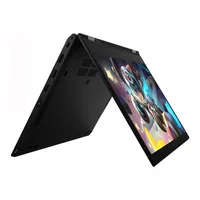Here’s the best alternative to Microsoft's Surface Laptop Go for Business
Is it worth buying this new budget enterprise laptop?
Lenovo ThinkPad L13 Yoga - $769.99 at Amazon
(roughly £600)
The best alternative to Microsoft's new business laptop is the Lenovo ThinkPad L13 Yoga, a true 2-in-1 convertible. It's heavier and a tad slower, but has more storage, a higher screen resolution, far more ports and costs less.
Microsoft has quietly launched the Surface Laptop Go for Business, with the cheapest model starting from $799. However, there appear to be plenty of competitive models around that are worth looking at too.
But first, let’s look at the main selling points of Microsoft's new laptop: it's very light and has a long battery life, powerful CPU, fast Wi-FI and a touch-capable display. It also offers a choice of three refreshing color schemes.
Microsoft is also the only vendor to offer a 36-month PCaaS-like scheme that allows businesses to buy their laptops in interest-free monthly instalments.
- Here's our list of the best mobile workstations out there
- We've built a list of the best laptops for video editing right now
- Check out our list of the best laptops for programming on the market
The Surface Laptop Go for Business also benefits from 60-day returns, up to 13 hours battery life thanks to extra optimizations and the Advanced Exchange program, which entitles you to an immediate replacement upon request.
On closer inspection, Microsoft has produced a very intriguing product with only one big flaw: its screen resolution is about a third lower than a full HD screen (the strict minimum we’d recommend for any business laptop).
The best alternative, in our eyes, is the Lenovo ThinkPad L13 Yoga, which costs slightly less, has more storage and boasts a superior display.
- Here's our list of the best laptops for DJs right now
Bear in mind
- If this product is unavailable in your region, you will need to use a specialist parcel forwarding service.
- If you've managed to get hold of a cheaper product with equivalent specifications, in stock and brand new, let us know and we'll tip our hat to you.
Sign up to the TechRadar Pro newsletter to get all the top news, opinion, features and guidance your business needs to succeed!

Désiré has been musing and writing about technology during a career spanning four decades. He dabbled in website builders and web hosting when DHTML and frames were in vogue and started narrating about the impact of technology on society just before the start of the Y2K hysteria at the turn of the last millennium.
